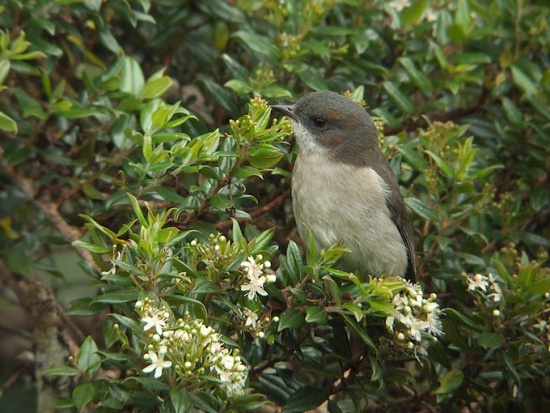(completed) |
|||
| Line 1: | Line 1: | ||
| − | + | [[Image:Brown-backed-Whistler-1.jpg|thumb|550px|right|Photo by {{user|Xenospiza|Xenospiza}}<br>Kumul Lodge, Enga, [[Papua New Guinea]], July 2006]] | |
| − | [[Image:Brown-backed-Whistler-1.jpg|thumb|550px|right|Photo by Xenospiza<br>Kumul Lodge, Enga, | + | '''Alternative name: Grey Mountain Pachycephala''' |
| − | |||
;[[:Category:Pachycephala|Pachycephala]] modesta | ;[[:Category:Pachycephala|Pachycephala]] modesta | ||
==Identification== | ==Identification== | ||
| + | 14cm. | ||
| + | * Dark grey crown | ||
| + | * Grey upper side of face to below orbit | ||
| + | * Brown ear-coverts | ||
| + | * Sooty brown upperparts with olive wash | ||
| + | * White throat and underparts | ||
| + | * Tinged grey flanks and breast | ||
| + | * Dark brown or red-brown iris | ||
| + | * Black bill and legs | ||
| + | Sexes alike. Juveniles are chestnut-brown to dark red-brown mottled | ||
==Distribution== | ==Distribution== | ||
| − | [[Papua New Guinea]]. | + | Endemic to [[Papua New Guinea]].<br /> |
| + | Locally fairly common. | ||
==Taxonomy== | ==Taxonomy== | ||
| − | There are 3 subspecies. | + | There are 3 subspecies: |
| + | * ''P. m. telefolminensis'' in the Victor Emanuel Mountains and Hindenburg Mountains | ||
| + | * ''P. m. hypoleuca'' in the mountains of Western, Southern and Eastern Highlands and Huon Peninsula | ||
| + | * ''P. m. modesta'' in the Herzog Mountains and mountains of southeast [[New Guinea]] | ||
==Habitat== | ==Habitat== | ||
| − | Moist montanes. | + | Moist montanes, sometimes small trees in alpine grassland. Found mainly from 1830m to the timber-line (around 3450m). |
==Behaviour== | ==Behaviour== | ||
| − | + | Feeds on insects, sometimes fruits.<br /> | |
| + | Forages in the canopy and middle storey.<br /> | ||
| + | Breeding probably in the latter part of the dry season and early in the wet season. No more information.<br /> | ||
| + | Probably a sedentary species. | ||
==References== | ==References== | ||
| − | + | #{{Ref-Clements6thDec08}}#{{Ref-HBWVol12}} | |
| + | {{ref}} | ||
==External Links== | ==External Links== | ||
{{GSearch|Pachycephala+modesta}} | {{GSearch|Pachycephala+modesta}} | ||
*[http://www.aviceda.org/abid/birdimages.php?action=birdspecies&fid=69&bid=1127 View more images of this species on the ABID] | *[http://www.aviceda.org/abid/birdimages.php?action=birdspecies&fid=69&bid=1127 View more images of this species on the ABID] | ||
[[Category:Birds]] [[Category:Pachycephala]] | [[Category:Birds]] [[Category:Pachycephala]] | ||
Revision as of 17:23, 10 November 2009
Alternative name: Grey Mountain Pachycephala
- Pachycephala modesta
Identification
14cm.
- Dark grey crown
- Grey upper side of face to below orbit
- Brown ear-coverts
- Sooty brown upperparts with olive wash
- White throat and underparts
- Tinged grey flanks and breast
- Dark brown or red-brown iris
- Black bill and legs
Sexes alike. Juveniles are chestnut-brown to dark red-brown mottled
Distribution
Endemic to Papua New Guinea.
Locally fairly common.
Taxonomy
There are 3 subspecies:
- P. m. telefolminensis in the Victor Emanuel Mountains and Hindenburg Mountains
- P. m. hypoleuca in the mountains of Western, Southern and Eastern Highlands and Huon Peninsula
- P. m. modesta in the Herzog Mountains and mountains of southeast New Guinea
Habitat
Moist montanes, sometimes small trees in alpine grassland. Found mainly from 1830m to the timber-line (around 3450m).
Behaviour
Feeds on insects, sometimes fruits.
Forages in the canopy and middle storey.
Breeding probably in the latter part of the dry season and early in the wet season. No more information.
Probably a sedentary species.
References
- Clements, JF. 2008. The Clements Checklist of Birds of the World. 6th ed., with updates to December 2008. Ithaca: Cornell Univ. Press. ISBN 978-0801445019.
- Del Hoyo, J, A Elliott, and D Christie, eds. 2007. Handbook of the Birds of the World. Volume 12: Picathartes to Tits and Chickadees. Barcelona: Lynx Edicions. ISBN 978-8496553422
Recommended Citation
- BirdForum Opus contributors. (2024) Brown-backed Whistler. In: BirdForum, the forum for wild birds and birding. Retrieved 28 April 2024 from https://www.birdforum.net/opus/Brown-backed_Whistler




